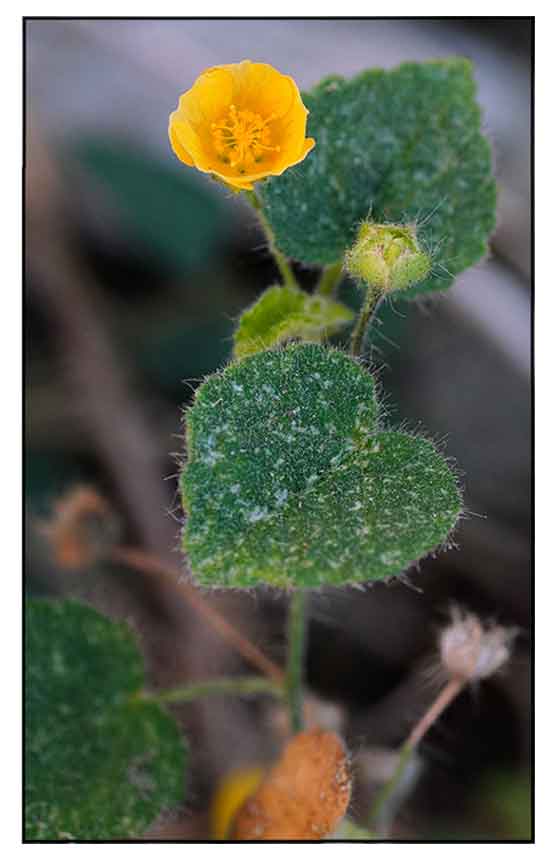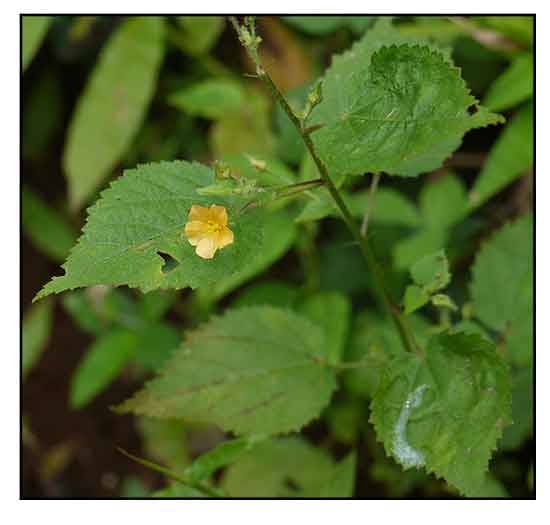 Gen info Gen info
- The genus name Sida derives from Greek for "pomegranate or water lily". Carl Linnaeus adopted the name from the writings of Theophrastus. The species epithet is derived from the name of the City of Mysore, India. (2)
Botany
Sida mysorensis is a subshrub-like herb, erect, to 1 m tall. Stem with minute stellate hairs, multicellular glandular hairs, and long simple hairs. Stipule filiform, ca. 5 mm; petiole 1-3 cm, pilose; leaf blade ovate-cordate, 3-6 × 2.5-4.5 cm, viscid-stellate on both surfaces with minute stellate hairs and multicellular glandular hairs, base cordate, margin crenate, apex acuminate. Flowers solitary or paired, axillary or subterminal, often on congested reduced axillary shoots. Pedicel slender, 2-6(-15) mm, articulate at or above middle. Calyx widely campanulate, 6-8 mm, sparsely pilose with long hairs, lobes 2.5-3 × ca. 2.5 mm, acute or acuminate. Corolla yellow, 1-1.2 cm in diam.; petals obtriangular, glabrous. Filament tube strigose. Schizocarp nearly globose, 3-4 mm in diam.; mericarps 5, ovoid-tetrahedral, ca. 2.5 mm, smooth, apex shortly hairy, not awned, shortly acute, enclosed in persistent calyx. Seeds ovoid, slightly 3-sided, ca. 2 mm, glabrous. (Flora of China)
Distribution
- Native to the Philippines.
- Also native to Assam, Bangladesh, Cambodia, China, Hainan, Himalaya, India, Laos, Malaya, Myanmar, Pakistan, Sri Lanka, Taiwan, Thailand, Vietnam. (1)
- Grows primarily in the wet tropical biome.
- In grassy slopes, roadsides, forest boundaries and waste places, up to 700 m altitude.
Constituents
- Aerial parts isolated a new ecdysone, glutinosterone (1). (see study below) (6)
- Study of methanolic root extract of Sida mysorensis yielded next highest total phenolic content with 1.66 mg CAE/g and 1.87 mg TAE/g, and next highest flavonoid content of 1.18 mg QE/g. (see study below) (3)
- Study of aerial parts isolated a new Ecdysterone, glutinosterone, along with polyphenolics, flavonoids, alkaloids, anthraquinone derivatives, glycosides, terpenoids, and steroids.
(7)
- Study of dried aerial parts of Sida glutinosa isolated a new flavonol glucoside, glutinoside (1), along with seven known compounds, 24(28)-dehydromakisterone A (2), 1,2,3,9-tetrahydropyrrolo[2,1-b]-quinazolin-3-amine (3), docosanoic acid (4), 1-triacontanol (5), campesterol (6), stigmasterol, and β-sitosterol (7). (8)
 Properties Properties
- Studies have suggested antioxidant, hepatoprotective, lipoxygenase inhibitory, anti-inflammatory properties.
Parts used
Leaves, roots, aerial parts.
Uses
Folkloric
- No reported folkloric medicinal use in the Philippines.
- In Ayurveda, used for treatment of wounds.
- In India, used for rheumatism and tuberculosis.
- In Purandhar,
powdered leaves used for healing wounds.
Others
- Fiber: In the Philippines, bast fibers are used to make rope.
Studies
• Antioxidant / Roots: Study evaluated methanolic root extracts of eight Sida species (S. acuta, S. cordota, S. cordifolia, S. indica, S. mysorensis, S. retusa, R. rhombofolia, S. spinosa) for phenolic content and antioxidant activities. Sida mysorensis yielded next highest total phenolic content with 1.66 mg CAE/g and 1.87 mg TAE/g, and next highest flavonoid content of 1.18 mg QE/g. It showed moderate antioxidant activity with DPPH, FRAP and ABTS assays. (3)
• Reinforcement in Polymer Composite / Fiber: Study evaluated the physicochemical, thermal, and surface morphological properties of S. mysorensis fibers. Results showed SMF can be used as reinforcement in polymer composites. (4)
• DEHP / Lipoxygenase (LOX) Inhibitory Activity: LOX is the key enzyme in the biosynthesis of leukotrienes, which is postulated to play an important role in the pathophysiology of several inflammatory and allergic diseases. Study evaluated the LOX inhibitory activity of some Sida species. The LOX inhibitor was di(2ethylhexyl) phthalate, which binds perfectly into the active site of LOX to inhibit it. Four of six plants showed the presence of DEHP at considerably high concentration. Sida mysorensis yielded 0.19 ± 0.009 % DEHP w/w. Results suggest a possible molecular anti-inflammatory mechanism. (5)
• Antibacterial / Hepatoprotective / Glutinosterone / Aerial Parts: Study of aerial parts isolated a new ecdysone, glutinosterone. Structure was elucidated as 1β-hydroxy 24(28)-dehydromakisterone A. The compound exhibited significant effect on different enzymes involved in human liver function along with lipid metabolic enzymes. It also exhibited significant anti-bacterial activity against Escherichia coli and Bacillus subtilis. Results suggest Glutinosterone may be an effective drug for treatment of human hepatic disorders and also have moderate to significant antibacterial activity. (6)
• Enzyme Inhibitory Activity / Antimicrobial / Aerial Parts: Study of Sida glutinosa isolated glutinoside (1) and 24(28)-dehydromakisterone A (2). Study evaluated the role of the compounds on enzymes generally used as marker for hepatic functions (ALT, AST, alkaline phosphatase) lipid metabolic enzyme, and antibacterial function. Results showed significant reduction in enzyme expression in their optimum inhibitory concentration. Both compounds showed antibacterial properties against both gram positive and gram negative bacteria compared to standard drug gentamicin. (9)
Availability
Wild-crafted.
|

![]()





